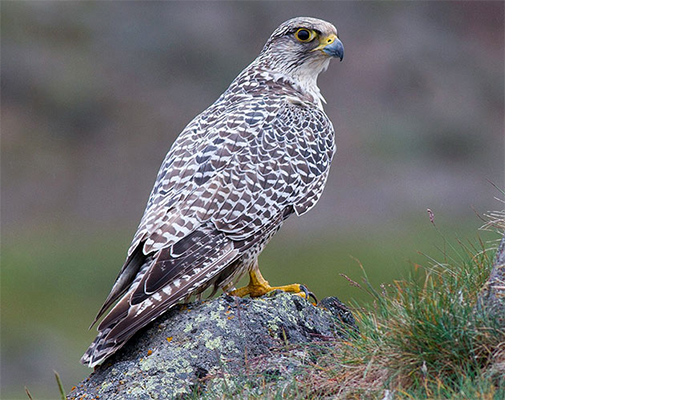
English: Gyr Falcon, Jer Falcon,
Iceland Falcon, Greenland Falcon
Russian: Кречет
German: Gerfalke
French: Faucon gerfaut
Mongolian: Цагаан шонхор, Жадан
шонхор
Japanese: シロハヤブサ (Shiro-hayabusa)
Body Length: 53-63 cm
Wing span: 109-134 cm
Habitat: Resident in mountains and tundra, preferring canyons in
birch zone, or tundra with crags and patches of trees and scrub. Vagrant
to Britain & Ireland, about 3-4 records annually. Food taken on ground or
in air, birds (mainly Rock Ptarmigan), lemmings and other small mammals. Nest
on cliff-ledge, often revealed by abundance of yellowish-green lichens growing
beneath on rock.
Identification:
Largest falcon, wingspan as Common Buzzard. Wings broad, wing-tips rather
rounded for a falcon. Tal slightly longer than on Peregrine Falcon, the other
large falcon within same range. Body weighty, as Peregrine’s, but longer, and
base of tail broad (undertail-coverts bulky, as on Goshawk). Flight similar to
Peregrine, but owing to larger size and slightly longer ‘arm’ more stable, with
somewhat slower and more shallow, elastic wingbeats. Aerial hunts mainly by
horizontal pursuit, often low over ground; ♂ and ♀ can co-operate to exhaust
prey; only rarely stoops from height like Peregrine; prey often taken on
ground. Plumage variation basically geographical, but overlap and variation
substantial: attractive white morph (predominating Greenland, also occurring
Siberia) is white with dark wing-tips and some dark spotting; light grey morph
(Iceland) is pale grey with whitish barring; dark grey morph (Fenno-Scandia,
Russia) is medium grey with pale grey barring. Last two have narrow and
indistinct moustachial stripe, pale supercilium, and finely streaked or dusky
cheeks.
- Adult,
grey morphs: Cere and feet are yellow; upperparts greyish (or greyish-brown),
barred or spotted pale ash-grey; underparts rather finely spotted and streaked dark,
some cross-barring on flanks and ‘trousers’ on most.
- Juvenile:
Cere and feet bluish (at least through 1st winter); upperparts are dark
brown-grey, with very little or no pale barring or spotting except on tail:
underparts boldly streaked dark, no barring.